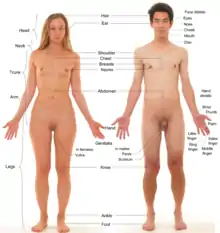Male
A male (♂) organism is the physiological sex that produces the gamete known as sperm.[1][2][3] A male gamete can fuse with a larger female gamete, or ovum, in the process of fertilization. A male cannot reproduce sexually without access to at least one ovum from a female, but some organisms can reproduce both sexually and asexually.[4] Most male mammals, including male humans, have a Y chromosome,[5][6] which codes for the production of larger amounts of testosterone to develop male reproductive organs. Not all species share a common sex-determination system. In most animals, including humans, sex is determined genetically; however, species such as Cymothoa exigua change sex depending on the number of females present in the vicinity.[7] Male can also be used to refer to gender.

Overview
The existence of two sexes seems to have been selected independently across different evolutionary lineages (see convergent evolution).[8][1] The repeated pattern is sexual reproduction in isogamous species with two or more mating types with gametes of identical form and behavior (but different at the molecular level) to anisogamous species with gametes of male and female types to oogamous species in which the female gamete is very much larger than the male and has no ability to move. There is a good argument that this pattern was driven by the physical constraints on the mechanisms by which two gametes get together as required for sexual reproduction.[9]
Accordingly, sex is defined across species by the type of gametes produced (i.e.: spermatozoa vs. ova) and differences between males and females in one lineage are not always predictive of differences in another.[1][10][11]
Male/female dimorphism between organisms or reproductive organs of different sexes is not limited to animals; male gametes are produced by chytrids, diatoms and land plants, among others. In land plants, female and male designate not only the female and male gamete-producing organisms and structures but also the structures of the sporophytes that give rise to male and female plants.
Symbol and usage
Symbol
A common symbol used to represent the male sex is the Mars symbol ♂, a circle with an arrow pointing northeast. The Unicode code-point is:
- U+2642 ♂ MALE SIGN (HTML
♂·♂)
The symbol is identical to the planetary symbol of Mars. It was first used to denote sex by Carl Linnaeus in 1751. The symbol is sometimes seen as a stylized representation of the shield and spear of the Roman god. Mars. According to Stearn, however, this derivation is "fanciful" and all the historical evidence favours "the conclusion of the French classical scholar Claude de Saumaise (Salmasius, 1588–1683)" that it is derived from θρ, the contraction of a Greek name for the planet Mars, which is Thouros.[12]
Usage
In addition to its meaning in the context of biology, male can also refer to gender[13] or a shape of connectors.[14][15]
Sex determination

The sex of a particular organism may be determined by a number of factors. These may be genetic or environmental, or may naturally change during the course of an organism's life. Although most species have only two sexes (either male or female),[8][1][16] hermaphroditic animals, such as worms, have both male and female reproductive organs.[17]
Genetic determination
Most mammals, including humans, are genetically determined as such by the XY sex-determination system where males have an XY (as opposed to XX) sex chromosome. It is also possible in a variety of species, including humans, to be XX male or have other karyotypes. During reproduction, a male can give either an X sperm or a Y sperm, while a female can only give an X egg. A Y sperm and an X egg produce a male, while an X sperm and an X egg produce a female.[18]
The part of the Y-chromosome which is responsible for maleness is the sex-determining region of the Y-chromosome, the SRY.[19] The SRY activates Sox9, which forms feedforward loops with FGF9 and PGD2 in the gonads, allowing the levels of these genes to stay high enough in order to cause male development;[20] for example, Fgf9 is responsible for development of the spermatic cords and the multiplication of Sertoli cells, both of which are crucial to male sexual development.[21]
The ZW sex-determination system, where males have a ZZ (as opposed to ZW) sex chromosome may be found in birds and some insects (mostly butterflies and moths) and other organisms. Members of the insect order Hymenoptera, such as ants and bees, are often determined by haplodiploidy, where most males are haploid and females and some sterile males are diploid.
Environmental determination
In some species of reptiles, such as alligators, sex is determined by the temperature at which the egg is incubated. Other species, such as some snails, practice sex change: adults start out male, then become female.[22] In tropical clown fish, the dominant individual in a group becomes female while the other ones are male.[23]
In some arthropods, sex is determined by infection. Bacteria of the genus Wolbachia alter their sexuality; some species consist entirely of ZZ individuals, with sex determined by the presence of Wolbachia.
Secondary sex characteristics
In those species with two sexes, males may differ from females in ways other than the production of spermatozoa.
In many insects and fish, the male is smaller than the female.
In seed plants, which exhibit alternation of generations, the female and male parts are both included within the sporophyte sex organ of a single organism.
In mammals, including humans, males are typically larger than females.[24]
In humans, males have more body hair and muscle mass.[25]
In birds, the male often exhibits a colorful plumage that attracts females.[26]
See also
| Look up male in Wiktionary, the free dictionary. |
| Wikimedia Commons has media related to males. |
References
- "4.9: Sexual dimorphism". Biology LibreTexts. 2016-06-04. Retrieved 2020-07-22.
- Lehtonen, Jussi; Parker, Geoff A. (2014-12-01). "Gamete competition, gamete limitation, and the evolution of the two sexes". Molecular Human Reproduction. 20 (12): 1161–1168. doi:10.1093/molehr/gau068. ISSN 1360-9947. PMID 25323972.
- Lehtonen, Jussi (2017), "Gamete Size", in Shackelford, Todd K.; Weekes-Shackelford, Viviana A. (eds.), Encyclopedia of Evolutionary Psychological Science, Cham: Springer International Publishing, pp. 1–4, doi:10.1007/978-3-319-16999-6_3063-1, ISBN 978-3-319-16999-6
- Lively, Curtis M. (2010-03-01). "A Review of Red Queen Models for the Persistence of Obligate Sexual Reproduction". Journal of Heredity. 101 (suppl_1): S13–S20. doi:10.1093/jhered/esq010. ISSN 0022-1503. PMID 20421322.
- Reference, Genetics Home. "Y chromosome". Genetics Home Reference. Retrieved 2020-07-22.
- "Y Chromosome". Genome.gov. Retrieved 2020-09-07.
- Creighton, Jolene. "Meet The Sex-Changing, Tongue-Eating Parasite". From Quarks to Quasars. Archived from the original on November 7, 2013. Retrieved 7 April 2014.
- "Sex". Encyclopedia Britannica. Retrieved 2020-07-22.
- Dusenbery, David B. (2009). Living at Micro Scale. Cambridge, Massachusetts: Harvard University Press. Chapter 20. ISBN 978-0-674-03116-6..
- Wilcox, Christie. "Why Sex? Biologists Find New Explanations". Quanta Magazine. Retrieved 2020-07-22.
- Lehtonen, Jussi (2017), "Gamete Size", in Shackelford, Todd K.; Weekes-Shackelford, Viviana A. (eds.), Encyclopedia of Evolutionary Psychological Science, Cham: Springer International Publishing, pp. 1–4, doi:10.1007/978-3-319-16999-6_3063-1, ISBN 978-3-319-16999-6
- Stearn, William T. (1962). "The Origin of the Male and Female Symbols of Biology". Taxon. 11 (4): 109–113. doi:10.2307/1217734. JSTOR 1217734.
- Laura Palazzani; Victoria Bailes; Marina Fella (2012). Gender in Philosophy and Law. SpringerBriefs in law. Dordrecht : Springer. p. v. ISBN 9789400749917.
'gender' means human gender, male/female gender
CS1 maint: uses authors parameter (link) (eBook) - J. Richard Johnson (1962). How to Build Electronic Equipment. New York: Rider. p. 167.
To minimize confusion, the connector portions with projecting prongs are referred to as the 'male' portion, and the sockets as the 'female' portion.
- Richard Ferncase (2013). Film and Video Lighting Terms and Concepts. Hoboken Taylor and Francis. p. 96. ISBN 9780240801575.
female[:] Refers to a socket type connector, which must receive a male connector
- Fusco, Giuseppe; Minelli, Alessandro (2019-10-10). The Biology of Reproduction. Cambridge University Press. ISBN 978-1-108-49985-9.
- "hermaphroditism | Definition, Types, & Effects". Encyclopedia Britannica. Retrieved 2020-07-22.
- "43.1C: Sex Determination". Biology LibreTexts. 2018-07-17. Retrieved 2020-07-22.
- Reference, Genetics Home. "SRY gene". Genetics Home Reference. Retrieved 2020-07-22.
- Moniot, Brigitte; Declosmenil, Faustine; Barrionuevo, Francisco; Scherer, Gerd; Aritake, Kosuke; Malki, Safia; Marzi, Laetitia; Cohen-Solal, Ann; Georg, Ina; Klattig, Jürgen; Englert, Christoph; Kim, Yuna; Capel, Blanche; Eguchi, Naomi; Urade, Yoshihiro; Boizet-Bonhoure, Brigitte; Poulat, Francis (2009). "The PGD2 pathway, independently of FGF9, amplifies SOX9 activity in Sertoli cells during male sexual differentiation". Development. 136 (11): 1813–1821. doi:10.1242/dev.032631. PMC 4075598. PMID 19429785.
- Kim, Y.; Kobayashi, A.; Sekido, R.; Dinapoli, L.; Brennan, J.; Chaboissier, M. C.; Poulat, F.; Behringer, R. R.; Lovell-Badge, R.; Capel, B. (2006). "Fgf9 and Wnt4 Act as Antagonistic Signals to Regulate Mammalian Sex Determination". PLOS Biology. 4 (6): e187. doi:10.1371/journal.pbio.0040187. PMC 1463023. PMID 16700629.
- Cahill, Abigail E.; Juman, Alia Rehana; Pellman-Isaacs, Aaron; Bruno, William T. (December 2015). "Physical and Chemical Interactions with Conspecifics Mediate Sex Change in a Protandrous Gastropod Crepidula fornicata". The Biological Bulletin. 229 (3): 276–281. doi:10.1086/bblv229n3p276. ISSN 0006-3185. PMID 26695826. S2CID 22783998.
- Bull, J. J. (March 1980). "Sex Determination in Reptiles". The Quarterly Review of Biology. 55 (1): 3–21. doi:10.1086/411613. ISSN 0033-5770. S2CID 85177125.
- Ellis, Lee; Hershberger, Scott; Field, Evelyn; Wersinger, Scott; Pellis, Sergio; Geary, David; Palmer, Craig; Hoyenga, Katherine; Hetsroni, Amir (2013-05-13). Sex Differences: Summarizing More than a Century of Scientific Research. Psychology Press. ISBN 978-1-136-87493-2.
- Richards, Julia E.; Hawley, R. Scott (2010-12-12). The Human Genome. Academic Press. ISBN 978-0-08-091865-5.
- switze, International Conference on Comparative Physiology 1992 Crans; Bassau, Short & (1994-08-04). The Differences Between the Sexes. Cambridge University Press. ISBN 978-0-521-44878-9.
Further reading
- Wedgwood, Hensleigh (1855). "On False Etymologies". Transactions of the Philological Society (6): 68.